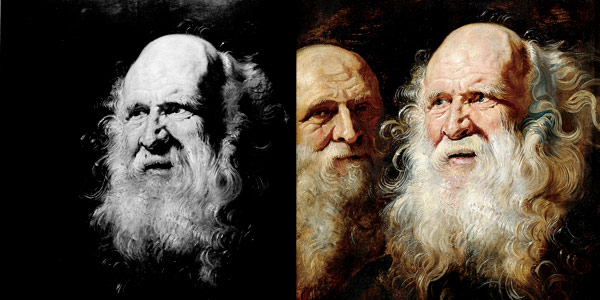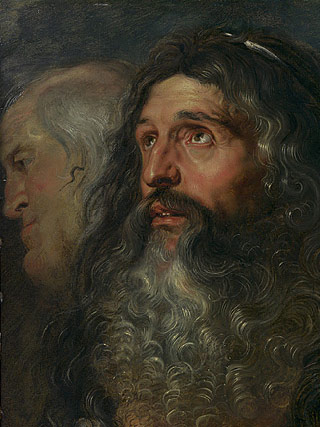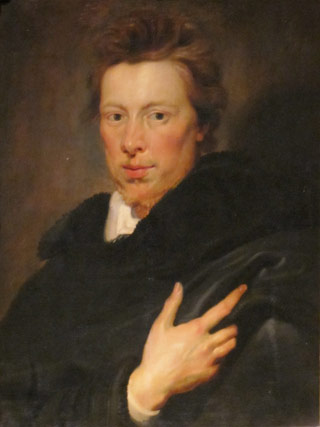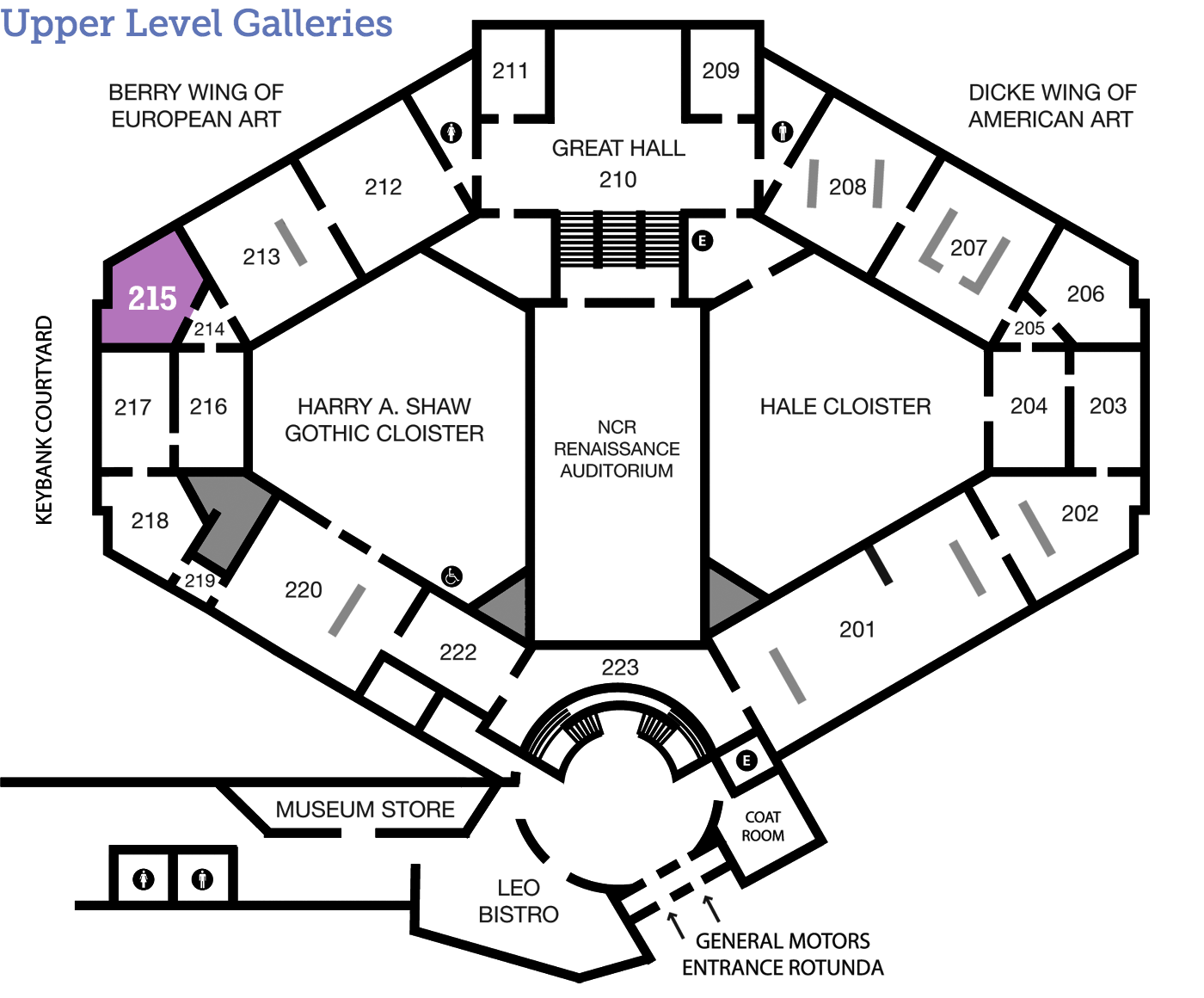
Sir Peter Paul Rubens
Study of Heads of an Old Man
(1577–1641)
Flemish c. 1612 Oil on oak panel 26 1/2 x 19 3/4 inches Frame: 34 1/2 x 27 3/4 x 4 1/2 inches Gift of Mr. and Mrs. Carlton W. Smith 1960.82
Seeing Double
Do you notice anything unusual about this painting? When Peter Paul Rubens, one of the most famous painters of the 1600s, painted this study for a larger painting, he had no idea what it would go through hundreds of years later.
A Day in the Life
Tools and Techniques
Behind the Scenes
Two Heads are Better than One

When The DAI acquired this painting only the right head was visible, but there was a possibility that a second face was concealed. Subtle differences in the paint on the left side suggested this, along with the fact that Rubens made several studies with multiple heads on one panel, such as this one from the Metropolitan Museum of Art.

Peter Paul Rubens (Flemish, 1577-1640), Study of Two Heads, oil on wood, 27 1/2 x 20 1/2 inches. The Metropolitan Museum of Art, New York, Bequest of Miss Adelaide Milton de Groot (1876–1967), 1967 (67.187.99) (artwork in the public domain; photograph provided by The Metropolitan Museum of Art, www.metmuseum.org).
The DAI's painting went to the Intermuseum Conservation Association laboratory in Oberlin, Ohio for conservation work in 1967, specifically to flatten the warp in the wooden board that is the support of the painting. At this time x-rays confirmed that the second head had been painted over at a much later date. In her report to The DAI, conservator Anne F. Clapp noted:
The x-radiographs show that to the left of the visible head there is another head of the same model in a different posture. The second head was not concealed by the original artist because the covering paint is readily affected by resin solvents, as is the restorer’s paint found over losses.
Then, in 1990, the painting was sent back to Oberlin for further conversation, this time to remove discolored layers of varnish on the surface. At this time The DAI decided to also have conservators remove the painting over the second head. You can clearly see the paint that was added later in the ultraviolet photo from the lab below. Over a course of nine months conservators removed surface dirt, the layers of varnish, and the added paint, and then applied new varnish and polished the surface, resulting in the condition you see today.
Look Closer
Just for Kids
Imagine!
When this painting came to the museum it showed only one head. After conservation, x-rays revealed that the painting contained another head. Paint was removed to uncover the left head. Why do you think one head was painted over? Do you think the artist did it? Why?
Look around the other galleries. Choose a painting you think has a secret under the paint. Write a story about what was painted over and why. Share your story with a friend.
Signs & Symbols
Dig Deeper
Arts Intersected
Audio Antwerp
What music might Rubens have listened to? Find out by listening to the Dayton-based Wind in the Woods Early Music Ensemble perform the song “Pagget” by the English composer Peter Phillips (1560/1561–1628), who lived in Antwerp at the same time as Rubens.
Performed by Margaret Erin, Jean Hutslar, Elizabeth Morris, Lawrence Pitzer, Sally Snyder. Recorded by Christopher Erin.
For more information on performances and recordings by Wind in the Woods Early Music Ensemble, please visit http://www.windinthewoodsearlymusic.com.
The Sculpture Speaks
Did You Know?
Expert Opinion
Well-prepared
If you looked at “Behind the Scenes,” you know that one of the heads was already painted over when The DAI acquired this painting. Why would someone do that? And now that we know that it is a study instead of a finished portrait, why would you make a study? Find out more from Alex Nyerges, Director and CEO of The DAI from 1992–2006, in the following audio clip.
When this work was acquired by the museum in 1960, it was a work by Rubens but it was The Portrait of an Old Man. The painting is now two pictures of that same old man and it is really just a study. The story behind its conservation and restoration really speaks to the fickleness of style and fashion. Sometime, we believe probably in the late 19th century/ early 20th century, someone—possibly a dealer or an artist working for a dealer/ conservator—painted over the second face so that the painting would only display the portrait of the man on the right side of the picture. When the work was x-rayed and we were working to do some conservation on it, we made the decision (rightfully so) to have it taken back to its original and intended fashion. Rubens intended this to be a study. He was working on one of his probably large, monumental canvases that would have included this gentleman, in some fashion, in a group scene expressing what might appear to be amazement, and in the other a great deal of contemplation. Rubens worked in a time when doing a number of preparatory sketches in oils was just part of the process. This gentleman appears in, apparently, more than thirty of his larger works.
One face in this study bears a close resemblance to a figure in Ruben’s painting Christ and the Adulterous Woman at the Royal Museum of Fine Arts of Belgium, Brussels. You can see an image of it here. Consider how the man’s face and expression changes when it is placed in the larger context of the other figures, as well as this particular story, instead of being seen in isolation.
Look Around
The Rubens Next Door
There are two paintings by Peter Paul Rubens in The DAI’s collection. The other one is a finished portrait of Daniel Nijs, who was an art dealer for Rubens. It is right next to Study of Heads of an Old Man in Gallery 215. Which one appeals to you more?

Peter Paul Rubens (Flemish, 1577–1641), Portrait of Daniel Nijs, c. 1612–1615, oil on oak panel, 25 ¾ x 19 inches. Gift of Mr. Benno M. Bechhold and museum purchase with funds provided by Mr. and Mrs. Carlton W. Smith, 1959.158.
Poll
About the Artist
Talk Back
Put yourself in the museum’s shoes!
In 1991 The DAI decided to uncover the second head that had been painted over (see “Behind the Scenes”). There are always limited risks involved in doing conservation. If you had to make the decision, what would you do? Does knowing that it is a study rather than a finished portrait change how you appreciate the painting? What if it had been Rubens himself who painted over the second head?

